
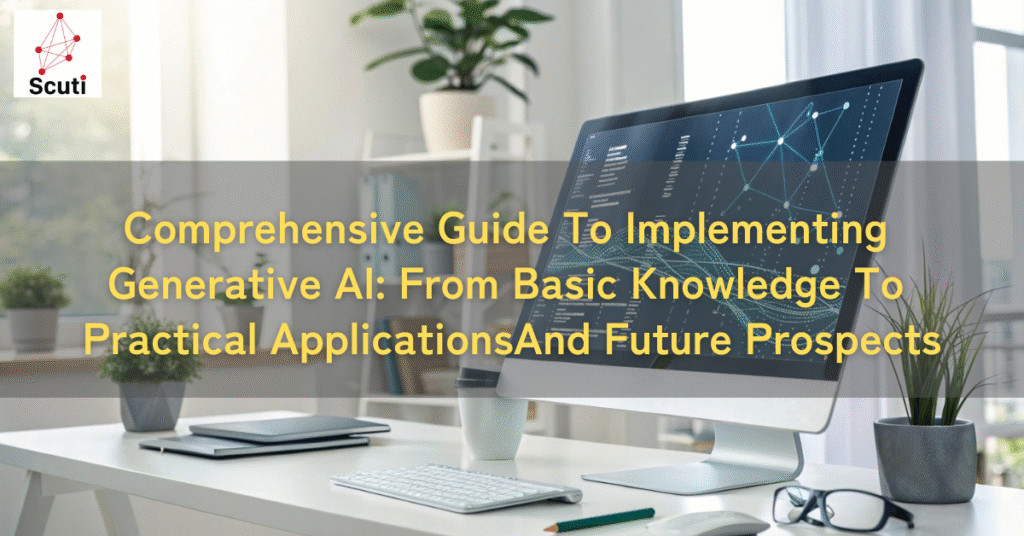
Hello, I am Kakeya, the representative of Scuti.
Our company specializes in services such as offshore development and lab-type development in Vietnam, as well as generative AI consulting. Recently, we have been fortunate to receive numerous requests for system development in collaboration with generative AI.
Many people who are considering the adoption of generative AI may feel uncertain about how to start. Unlike traditional AI, generative AI is an advanced technology capable of creating new content. Its applications are expected to drive efficiency in operations, enhance customer experiences, and support the development of new products and services across various fields.
However, adopting generative AI comes with several challenges, including selecting the appropriate model, preparing data, and addressing ethical considerations. This article provides a detailed explanation from the foundational knowledge needed for generative AI adoption to specific use cases and even future prospects. It comprehensively covers key points necessary for successfully implementing generative AI, so we encourage you to read it to the end.
In this article, we will delve into the basics of generative AI, representative models, use cases, points to note during implementation, and future predictions in detail.

Basic Knowledge and Characteristics of Generative AI
Definition and Working Principles of Generative AI
Generative AI refers to artificial intelligence that learns from existing data and creates new data. For example, a generative AI trained on a large number of cat images can generate new cat images that have never existed before.
This is because generative AI identifies the characteristics of cat images and uses those features to create new ones. The mechanism of generative AI is based on a process that extracts features from data and generates new data based on those features.
This technology is not only applied to images and text but also to the generation of audio and video, making it useful in various fields. The applications of generative AI continue to expand, and new possibilities are expected to emerge in the future. The evolution of generative AI pushes the boundaries of technology and offers new avenues for application.
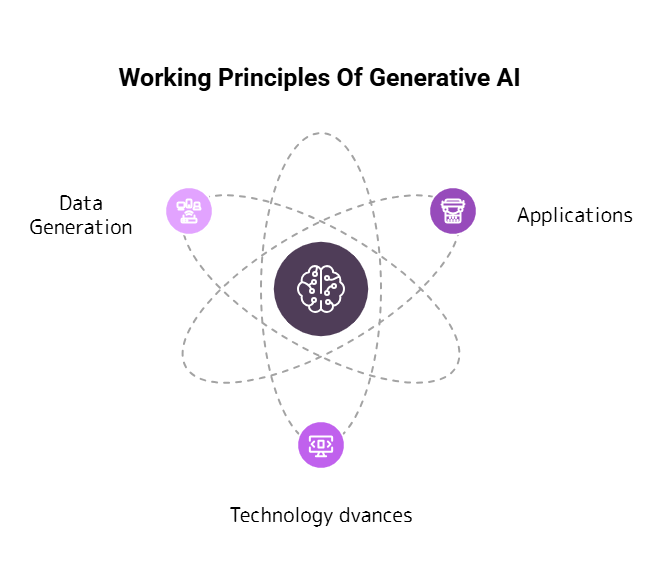
Differences Between Generative AI and Traditional AI
Traditional AI primarily focuses on analyzing and classifying data. For example, systems that analyze customer purchase histories to recommend optimal products for each individual are typical of traditional AI. In contrast, generative AI differs significantly by creating new data. This capability enables more innovative applications in creative fields and content production.
Because generative AI possesses the ability to generate data, it can provide new value that traditional AI could not achieve. As a result, its applications are expanding across various fields, such as business, entertainment, and education. The evolution of generative AI surpasses the limitations of traditional AI technology and opens new possibilities. By leveraging its data-generation capabilities, generative AI drives innovation in a wide range of domains
Evolution and History of Generative AI
Generative AI has evolved rapidly in recent years. Advances in deep learning technology, in particular, have enabled the generation of more complex and higher-quality data. While early generative AI was limited to creating simple images and text, the latest generative AI can produce highly realistic images indistinguishable from photographs and natural text that resembles human-written content.
This evolution has expanded the applications of generative AI across various fields. The history of generative AI demonstrates how its applications have broadened alongside technological advancements. Further evolution is anticipated, opening new possibilities. The advancement of generative AI continues to push the boundaries of technology and offer new avenues for application. By leveraging its data-generation capabilities, generative AI fosters innovation in numerous domains.
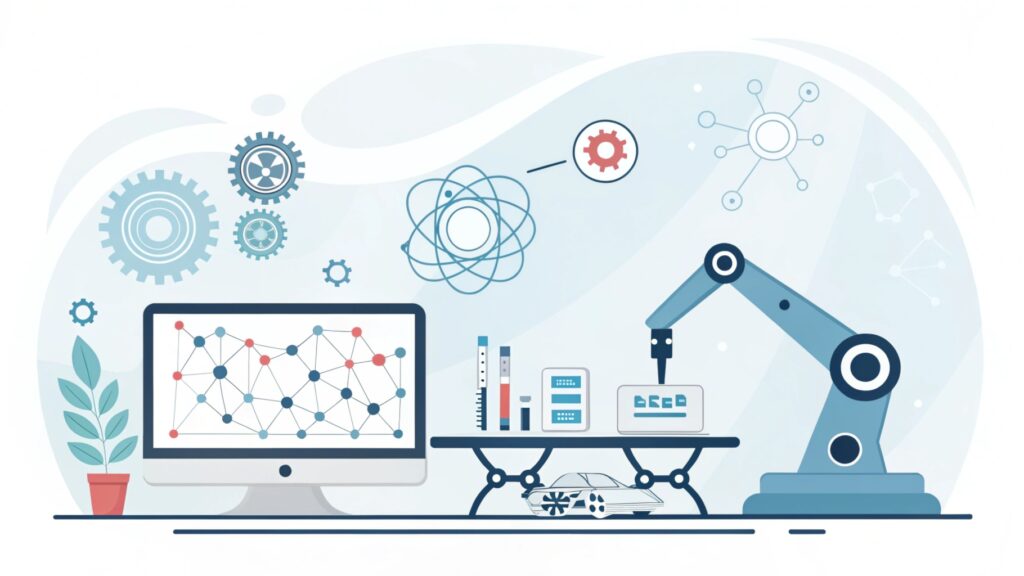
Introduction to Representative Generative AI Models
GAN (Generative Adversarial Network
GAN is a model that generates more realistic data by having two neural networks, the Generator and the Discriminator, compete against each other. The Generator creates fake data, while the Discriminator determines whether the data is real or fake. Through this competition, the Generator gradually acquires the ability to produce data realistic enough to deceive the Discriminator.
The mechanism of GAN involves the Generator and Discriminator competing with each other, which enhances the Generator’s ability to create higher-quality data. This process enables generative AI to produce more realistic and reliable data.
The applications of GAN are not limited to image and video generation but are also expected to be utilized in various fields. The technology of GAN leverages its data-generation capabilities to drive innovation across different domains.
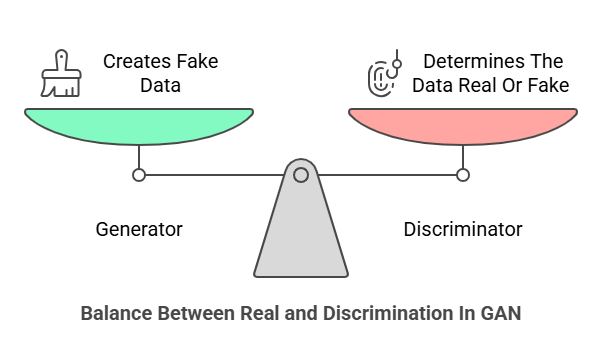
Application of GAN in Image and Video Generation
GAN is widely utilized in generating images and videos. For instance, it can convert low-resolution images to high-resolution ones or transform black-and-white images into color images. Additionally, GAN enables technologies that interpolate between video frames, creating smoother videos. These advancements have led to significant applications in video production and digital content creation.
Moreover, GAN expands the possibilities of new visual expressions and plays a vital role in creative projects. The technology contributes to improving the efficiency and quality of video production, with its applications expected to grow further. By leveraging its data-generation capabilities, GAN drives innovation across various domains.
Application of GAN in Security and Privacy
GAN is also beneficial in the fields of security and privacy. For example, it can anonymize data containing personal information or generate fake data to protect systems from attacks. These applications enable the safeguarding of data security while maintaining privacy.
As a new measure for security, GAN is gaining attention, and its usage is anticipated to expand further. GAN provides novel approaches to enhance data security and fosters innovation in the field of security by utilizing its data-generation capabilities.
Transformer Models
Transformer models are widely used in the field of natural language processing (NLP). They learn the relationships between words in sentences and have the ability to generate more natural and contextually appropriate text. The hallmark of Transformer models lies in their high flexibility and efficiency.
This capability enables learning from large datasets, facilitating advanced NLP tasks. Transformer models have opened up new possibilities in NLP, and their applications are expected to continue expanding. By leveraging its data-generation capabilities, the technology of Transformer models drives innovation in various domains.
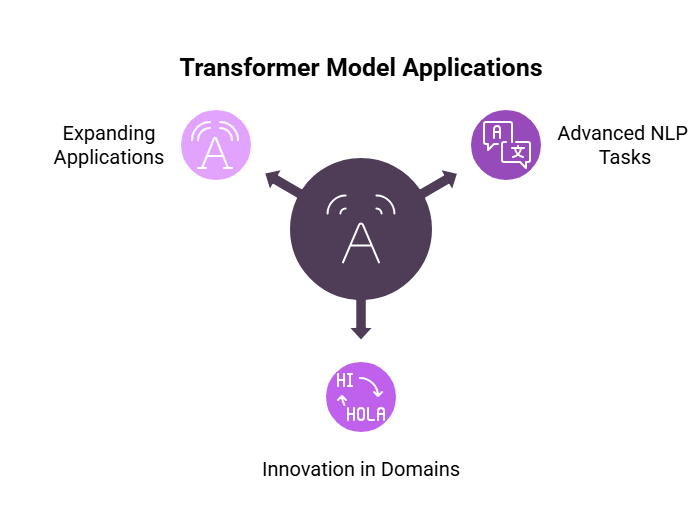
GPT Series: From GPT-3 to Meta’s LLaMA
The GPT series, developed by OpenAI, comprises large-scale language models. Particularly, GPT-3 has learned from massive text data, enabling it to generate human-like natural language. Furthermore, LLaMA, developed by Meta, achieves comparable performance with fewer parameters than GPT-3, allowing for more efficient utilization.
This has led to advancements in various applications, driving innovation in natural language processing (NLP). The GPT series contributes to improving the efficiency and quality of NLP and is expected to find broader applications in the future. By leveraging its data-generation capabilities, the GPT series fosters innovation across diverse domains.
BERT and Its Applications in Natural Language Processing
BERT, developed by Google, is a language model capable of understanding the context of words within sentences. This capability enables a wide range of applications, including improving search engine accuracy and enhancing voice recognition systems. BERT’s strength lies in its high contextual understanding, which allows it to generate more natural and coherent text.
BERT has opened up new possibilities in NLP, with its applications expected to expand further. The technology provides innovative approaches to improve the accuracy and efficiency of NLP. By leveraging its data-generation capabilities, BERT fosters innovation across various domains.
Diffusion Models
Diffusion models are models that generate images by incrementally removing noise. By starting with random noise and gradually creating meaningful images, they can produce complex and high-quality visuals.
The strength of diffusion models lies in their high image-generation capabilities, enabling applications across various fields. Diffusion models have opened up new possibilities for image generation and are expected to find broader applications in the future. By leveraging its data-generation capabilities, diffusion models foster innovation across diverse domains.
Mechanism of Stable Diffusion
Stable Diffusion is a model that generates corresponding images based on text input. As a type of diffusion model, it achieves high-quality image generation. Its strengths lie in its high image-generation capabilities and flexibility, making it applicable to various use cases.
Stable Diffusion has opened up new possibilities in image generation and is expected to see further applications in the future. The technology contributes to improving the efficiency and quality of image generation, driving innovation across diverse fields.
Contributions of DALL·E 2 to Image Generation
DALL·E 2, developed by OpenAI, is an image-generation model capable of creating images based on user-provided text input. As a diffusion model, it possesses the ability to produce high-quality visuals. Its strengths lie in its high image-generation capabilities and flexibility, making it applicable to various applications.
DALL·E 2 has opened up new possibilities for image generation and is expected to expand its applications further. The technology contributes to enhancing the efficiency and quality of image generation, fostering innovation in diverse domains.
VAE (Variational Autoencoder)
VAE is a model that compresses data and restores the original data from the compressed form. During this process, it learns the features of the data, enabling the generation of new data. VAE’s strengths lie in its high data compression and reconstruction capabilities, allowing for applications across various fields.
VAE has opened up new possibilities for data generation and is expected to find broader applications in the future. By leveraging its data-generation capabilities, VAE fosters innovation across diverse domains.
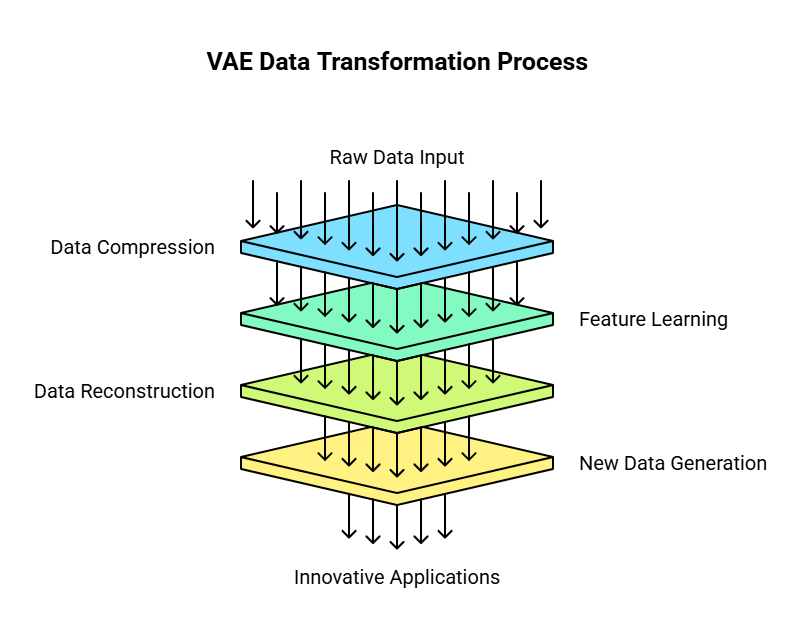
Applications of VAE in Image and Audio Generation
VAE is also applied to image and audio generation. For instance, its capabilities are utilized in generating facial images and audio signals, among other areas. VAE’s strength lies in its high data-generation capability and flexibility, which enable its application in various fields.
VAE has opened up new possibilities in image and audio generation, and its applications are expected to expand further in the future. The technology of VAE contributes to improving the efficiency and quality of data generation, fostering innovation across diverse domains.
Applications of VAE in Security and Privacy
VAE is also employed in the fields of security and privacy. It is used for techniques such as anonymizing data containing personal information and generating fake data to protect systems from attacks. VAE’s strength lies in its high data-generation capability and flexibility, enabling its application in various use cases.
VAE has opened up new possibilities in security and privacy, with its applications anticipated to grow further. The technology of VAE provides innovative approaches to enhance data safety and fosters innovation in the field of security by leveraging its data-generation capabilities.

Diverse Use Cases of Generative AI
Image Generation
Transformation and Generation of Images
Generative AI is widely used in image transformation and generation. For example, it can convert low-resolution images to high-resolution, transform black-and-white images into color, and generate images from text descriptions. These capabilities streamline digital content creation and editing, playing a vital role in creative projects.
Generative AI’s image generation capabilities are expected to find applications across various fields, with its potential continuing to expand in the future. By improving the efficiency and quality of image generation, generative AI fosters innovation in diverse domains.
Enhancing Creativity with StyleGAN and DALL·E 2
StyleGAN and DALL·E 2, known for their high-quality image generation capabilities, have gained attention as tools that enhance creativity for artists and designers. These models improve the efficiency and quality of creative projects through their exceptional flexibility and image generation capabilities.
These technologies have opened new possibilities in creative fields, with their applications expected to grow further. By leveraging their data-generation capabilities, StyleGAN and DALL·E 2 promote innovation across various industries.
Text Generation
Principles of Text Generation Models
Text generation models learn from large volumes of text data, understanding sentence structure and context to create new, coherent sentences. These models’ strength lies in their ability to generate natural and contextually consistent text, enabling applications across diverse domains.
Text generation models have unlocked new possibilities in natural language processing (NLP), with their applications expected to expand further. By improving the efficiency and quality of text generation, these models foster innovation across various fields.
Applications in Chatbots, Summarization, and Translation
Text generation models are applied in areas such as chatbots, text summarization, and translation. These applications facilitate automated customer interactions and efficient processing of large amounts of information. The models’ high text-generation capabilities and flexibility allow for a wide range of use cases.
By advancing NLP applications, text generation models contribute to improving customer service efficiency and driving innovation in diverse industries.
Audio and Video Generation
Advancements in Audio and Video Generation Technologies
Audio and video generation technologies have rapidly evolved in recent years, enabling the creation of highly realistic and high-quality audio and video. This progress has broadened applications in entertainment, education, and other sectors. The technology’s strengths lie in its high generation capabilities and flexibility, making it suitable for diverse applications.
These advancements open new opportunities in entertainment and education, with their applications expected to grow further. By improving the efficiency and quality of audio and video generation, these technologies promote innovation across various fields.
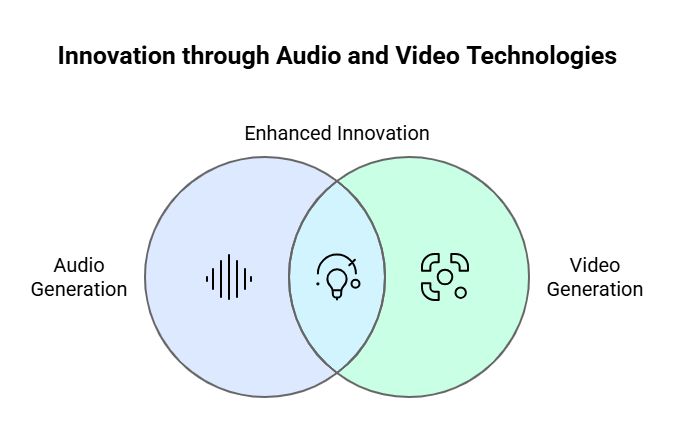
Applications in Text-to-Speech and Video Generation
In the field of audio technology, text-to-speech functions have advanced significantly, enabling the conversion of text into natural-sounding audio. Additionally, video generation technology now allows for the automatic creation of new videos based on specified content. These advancements have led to increased applications in education and entertainment.
The strengths of audio and video generation technologies lie in their high generative capabilities and flexibility, enabling their application across various fields. These technologies open up new possibilities in education and entertainment, with further expansion anticipated in the future. By improving efficiency and quality in education and entertainment, these technologies promote innovation in diverse domains.
Enhancing User Experience
Improving Customer Service and Engagement
Generative AI significantly contributes to automating customer service and enhancing customer engagement. Examples include swift customer responses via chatbots and the provision of personalized content. The flexibility and efficiency of generative AI make it applicable across various use cases.
Generative AI has opened up new opportunities in customer service and engagement, with its applications expected to grow further. By improving efficiency and quality in customer service, generative AI fosters innovation across diverse industries.
Personalization and Content Generation on Digital Platforms
Digital platforms are leveraging generative AI to enhance personalization features, such as recommending content tailored to user preferences or generating automated news articles. This enriches the user experience. Generative AI’s strengths in flexibility and efficiency enable its application across a wide range of scenarios.
Generative AI has unlocked new possibilities in digital platforms, with further applications expected to emerge. By enhancing efficiency and quality on digital platforms, generative AI drives innovation across various fields.

Points to Consider When Implementing Generative AI
Ethical Considerations
The adoption of generative AI involves ethical concerns, such as the potential generation of misinformation and privacy violations. It is crucial to implement appropriate measures to address these ethical issues when introducing generative AI. The technology’s high flexibility and efficiency enable its application in various domains.
Generative AI has the potential to address ethical challenges and its applications are expected to expand further. The technology contributes to solving ethical issues and fosters innovation across diverse fields by leveraging its data-generation capabilities.
Data Privacy and Security
Generative AI requires large amounts of data for training, which may include personal or sensitive information. Ensuring data privacy and security is essential when implementing this technology. Generative AI’s high flexibility and efficiency allow for diverse applications.
Generative AI has unlocked new opportunities in data privacy and security, with further applications expected in the future. It provides innovative approaches to enhance data safety and fosters innovation in the security field through its data-generation capabilities.
Copyright and Intellectual Property Issues
The handling of copyrights and intellectual property rights for content generated by generative AI is a critical issue. When adopting generative AI, it is necessary to carefully consider the legal aspects of these rights. The technology’s flexibility and efficiency make it applicable across various use cases.
Generative AI has opened up new possibilities in the field of copyright and intellectual property rights, and its applications are expected to grow further. By addressing these issues, generative AI contributes to innovation across various industries.

Future Predictions and Prospects of Generative AI
Evolution of Generative AI and Its Impact on Society
Generative AI is expected to continue evolving and significantly impact various fields. For example, it is anticipated to be utilized as a tool for advanced content creation and as an aid to human creativity. The flexibility and efficiency of generative AI enable its application in a wide range of domains.
Generative AI is opening up new possibilities in its societal impact, with its applications expected to expand further. The technology provides innovative approaches to enhance its influence on society and fosters innovation across various fields.
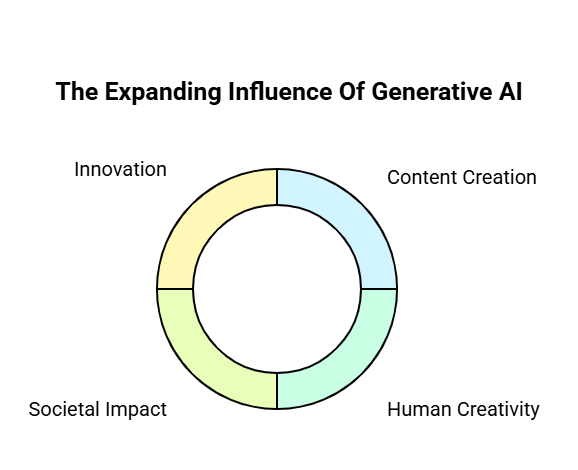
Innovation in Next-Generation Generative AI
Next-generation generative AI is anticipated to feature more human-like cognitive abilities and technologies that integrate the real and digital worlds. These advancements will enable even more sophisticated applications. Generative AI’s flexibility and efficiency allow for its application across diverse domains.
Generative AI is unlocking new possibilities in the field of next-generation innovation, with its applications expected to expand further. The technology fosters next-generation innovation and drives advancements across various fields.
Governance and Ethical Use of Generative AI
As generative AI evolves, discussions surrounding its governance and ethical use become increasingly important. Establishing rules and guidelines to ensure its safe and ethical application is essential. Generative AI’s flexibility and efficiency support its application in various scenarios.
Generative AI is opening new possibilities in governance and ethical use, with its applications anticipated to grow. The technology promotes governance and ethical utilization, driving innovation across numerous sectors while leveraging its data-generation capabilities.

Steps to Successfully Implement Generative AI
Generative AI is a technology with the potential to bring significant transformation to businesses. However, to successfully implement generative AI, it is essential to address several challenges, including selecting the appropriate model, preparing data, and considering ethical implications. By referring to the content introduced in this article, you can pave the way for the successful adoption of generative AI.
The strengths of generative AI lie in its high flexibility and efficiency, enabling its application across various domains. Generative AI is opening up new possibilities in the business sector, and its applications are expected to continue expanding in the future.
Generative AI contributes to improving business efficiency and quality while fostering innovation across multiple industries. By leveraging its data-generation capabilities, generative AI promotes advancements in various fields.
